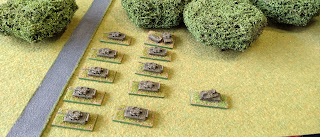Last weekend 6-7 April saw the welcome return of the Crisis Point event. Staged in the village of Dungworth just outside Sheffield by Richard Crawley, this weekend had been a highlight of the wargaming calender for many years but hasn't been staged for the last few years, because of reasons. This year Richard had a general theme of Invasion. As it transpired we ran 2 games, both set in the "Crawleyverse" alternative history Soviet invasion of Czechoslovakia in the summer of 1948, continuing the theme from last year's Joy of Six. Richard organised a large game using the TACWW2 rules. Lots of information about that game can be found over on his blog at thelandofcounterpane.blogspot.com. Meanwhile, m'colleague Neil and I ran a game using Cold War Commander.
I wanted a slightly different challenge to this game, rather than the standard line up the tanks and roll the dice affair. We had a large table, plenty of time but not a lot of miniatures to play with. We used the Breakthrough Attack scenario from the CWC2 rulebook, so the Soviet objective was to get 25% of their battlegroup off the other side of the table. The defending Czechoslovak forces had to prevent this from happening.
Neil's sketch map.
This is how that map translated to the table. The slightly beaten up village of Zblov is in the top left and the larger town of Zlic to the right.
I wanted to create a Soviet advance to contact, with a recce screen feeling out the defences before the main force arrived. Neil brought along a lot of recce units and also had 4 T34/85 Recce Support. The Soviet main force consisted of 2 battalions of T-44s, 2 battalions of infantry in half tracks or trucks, a battalion of JS3s and then various support elements such as mortars and HMGs, backed up by 152mm and rocket artillery. Neil took on the role of Soviet supreme commander, mentor and umpire, with new pals Dex and Rob playing as Soviets.
I acted as GOC and umpire for the Czechs l, with Phil and Ron as the Czechoslovak commanders. I decided to split the Czechs into a tank commander and infantry commander. Phil, the tank commander, had a battalion of T34/85, split into 3 companies of 3, along with a company of 3 infantry units in half-tracks, 2 82mm mortars and a towed quad AA gun. Infantry commander Ron had a battalion of infantry broken down into 3 companies of 3, some half-track transport, a company of 3 Hetzers, 2 Pak 40 AT guns, 2 mortars and another towed quad AA gun.
To help the game run as planned, the defending force started hidden, used the Hidden Units rule. It's the first time that I've tried these rules so I created these markers using 10mm Pendraken Soviet infantry.
I also gave the Czechs some Czech Hedgehog AT defences. These were very common in WW2 but apparently were not so effective against later, heavier tanks. We added a house rule that if a JS3 came into contact with one then they would sweep it aside on a 5+ roll on one D6 (apparently in real life a heavy tank would crush them up to 40% of the time).
Zblov, looking a bit battle worn. We thought that, in 1948, a lot of central Europe would still be in ruins after the War so we had a bombed out church, ruined houses and a tumble down graveyard.
The larger town of Zlic, at the heart of the Czech defences.
The game played out almost exactly as I intended. The Soviets pushed their Recce units forward, scouting out the Hidden Unit markers and revealing which ones were dummies and which concealed the defending troops. In fact, one Recce half-track made it across the board to Zlic and started heading back again before it was stopped by tank fire.
Once the hidden troops were revealed the Soviet main force arrived. The T44 battalions headed over the river on their right flank, making use of their dozer blade tanks to push aside the AT defences. The infantry battalions meanwhile took the more open ground on the left flank. This was the complete opposite of the Czech set up and meant that the T44s were opposed by dug-in infantry while the Soviet infantry came up mainly against tanks.
A Soviet recce unit gets too close to the enemy and pays the ultimate price, but reveals the dug-in infantry and Hetzers in the centre of the Czech line.
T44s advance on the Soviet right.
Facing the T44s were more dug-in infantry and the Pak 40s.
As Saturday progressed the T34s on the Czech right, along with multiple artillery strikes from their supporting 105mm gun battery, took a terrible toll on the Soviet infantry and that side of the battle had a Great War feel. On the Czech left, the Pak 40s were quickly despatched but the dug-in infantry continued to hold up the Soviet advance, helped by a truly shocking sequence of command rolls and blunders by the Soviets.
I confess, I have no idea what was happening on the other game throughout the weekend but here they are, battling away on the Sunday and seemingly having a great time. More info can be found on the other blogs etc.























































